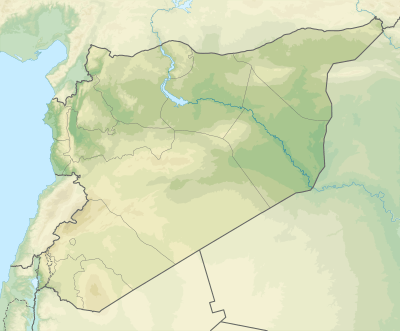Baath Dam
The Baath Dam (Arabic: سد البعث, lit. 'Dam of the Renaissance', Kurdish: Bendava Baas, Classical Syriac: ܣܟܪܐ ܕܒܥܬ, romanized: Sekro d'Ba'ath) is a dam on the Euphrates, located 22 kilometres (14 mi) upstream from the city of Raqqa in Raqqa Governorate, Syria. Construction of the dam started in 1983 and was finished in 1986. It is intended to generate hydroelectric power as well as regulate the irregular flow from the Tabqa Dam, which is located 18 kilometres (11 mi) upstream from the Baath Dam. These irregularities in the flow from the Tabqa Dam are caused by changes in the electricity demand.[1] The Baath Dam is 14 metres (46 ft) high and the installed water turbines can generate 81 MW. The storage capacity of the Baath Dam Reservoir is 0.09 cubic kilometres (0.022 cu mi).[2]
| Baath Dam | |
|---|---|
 Baath Dam (right), Tabqa Dam (centre), and Lake Assad (left) from space, June 1996. North is in the upper left corner of the image. | |
 Location of Baath Dam in Syria | |
| Official name | سد البعث |
| Location | Raqqa Governorate, Syria |
| Coordinates | 35°53′07″N 38°44′50″E |
| Construction began | 1983 |
| Opening date | 1986 |
| Dam and spillways | |
| Impounds | Euphrates |
| Height | 14 m (46 ft) |
| Reservoir | |
| Creates | Baath Dam Reservoir |
| Total capacity | 0.09 km3 (0.02 cu mi) |
| Power Station | |
| Installed capacity | 81 MW |
The Baath Dam is one of three dams on the Syrian Euphrates, the other two being the Tabqa Dam, and the Tishrin Dam 80 kilometres (50 mi) south of the Syria-Turkish border. Like the Baath Dam, the Tishrin Dam is also functionally related to the Tabqa Dam. Construction of the Tishrin Dam was partly motivated by the disappointing performance of the hydroelectric power station in the Tabqa Dam.[3] Before the Syrian Civil War, Syria had plans to construct a fourth dam – the Halabiye Dam – on the Euphrates, downstream from the Baath Dam.[4] The dam is named after the Syrian Arab Socialist Ba'ath Party.[5]
Syrian Civil War
On 4 February 2013, opposition forces captured the dam, a week before capturing the Tabqa Dam.[6][7] The Baath Dam was captured from the ISIL by the Syrian Democratic Forces on 4 June 2017. Upon doing so, they renamed it the "Freedom Dam" (Kurdish: Bendava Azadî; Arabic: سد الحرية; Classical Syriac: ܣܟܪܐ ܕܚܐܪܘܬܐ, romanized: Sekro d'Ḥirutho).[8] In 2019, control of the dam was given to the Syrian government after the Turkish invasion of Northern Syria.[5]
See also
Notes
- Shapland 1997, pp. 110–111
- Kliot 1994, p. 138
- Collelo 1987
- Jamous 2009
- "Syria revives important dam in Al-Raqqa". Al Masdar News. December 4, 2019. Retrieved December 4, 2019.
- Al Arabiya (4 February 2013). "الجيش السوري الحر يقتحم سد "البعث" على الفرات". Al Arabiya. Retrieved 12 February 2013.
- AP (February 11, 2013). "Syrian rebels capture country's largest dam". U.S. News & World Report. Retrieved February 11, 2013.
- "U.S.-backed Syrian forces seize dam west of Raqqa from Islamic State: SDF". Reuters. 4 June 2017.
References
- Collelo, Thomas (1987), Syria: A Country Study, Washington: GPO for the Library of Congress, OCLC 44250830
- Jamous, Bassam (2009), "Nouveaux aménagements hydrauliques sur le Moyen Euphrate syrienne. Appel à projets archéologiques d'urgence" (PDF), studiaorontica.org/ (in French), DGAM, retrieved 14 December 2009
- Kliot, Nurit (1994), Water Resources and Conflict in the Middle East, Milton Park: Routledge, ISBN 0-415-09752-5
- Shapland, Greg (1997), Rivers of discord: international water disputes in the Middle East, New York: Palgrave Macmillan, ISBN 978-0-312-16522-2